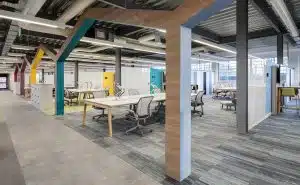Much research has shown that workplace environments are not only integral to employee physical and mental wellbeing but also productivity, retention rates and job satisfaction
The British Land’s Design for Life study in 2018, for example, revealed that design plays a huge role in stress levels, from the impact of noise levels and access to nature, to the number of sharp angles or blank walls in a space.
With the Centre for Mental Health claiming that mental health problems in the UK workforce cost employers almost £35 billion last year, which works out at around £1,300 for every employee in the UK, can organisations afford not to view employee wellbeing as a necessity when rethinking their workspaces?
While making workplaces more friendly, collaborative and relaxed, and implementing specific solutions such as free fruit, on-site showers, sleep pods etc, can form part of an overall wellbeing strategy and result in a happier workforce, there are more fundamental aspects that should be tackled first. Here we consider just a few of these factors, which often get overlooked when it comes to workplace design, but are crucial to supporting employee wellbeing and ultimately improving business success.
Air quality
In the current climate, there is increasing awareness that the quality of the air around us directly impacts on our health and wellbeing, with symptoms of exposure to poor air quality ranging from headaches, a dry throat, or eye irritation, to more severe reactions such as asthma attacks. As we spend on average 90% of our time within buildings, with a significant percentage of that being in our workplace, it’s crucial for organisations to implement design strategies which promote clean air.
With research suggesting that better air quality can also increase productivity by as much as 11%, there is a clear business case for this too. Measures organisations could adopt could include air filtration systems, the specification of low VOC materials and increasing ventilation rates.
Thermal comfort
Controlling the thermal environment is also key. Not only is thermal comfort linked to employees’ health, wellbeing and productivity, but it is also ranked as one of the highest contributing factors influencing overall human satisfaction in buildings. In fact, research indicates employees’ performance is 6% poorer when the office is overheated and 4% poorer when the office is cold. So by managing thermal comfort correctly within your office, you are likely to boost concentration and productivity as well as improving morale and wellbeing.
It’s important for organisations to realise that this is not just about temperature control, you also need to take into account a range of other environmental and personal factors including radiant temperature, air velocity, humidity, clothing insulation and metabolic heat. Mechanical systems should be designed to cope with fluctuation and to react to suit the occupier. Once occupying a space, businesses should also think about carrying out surveys with the team and thermal comfort assessments, in order to monitor comfort levels and make any necessary adaptions.
Lighting
Of course, everyone knows that lighting is essential, but it can often get overlooked in the workplace where wellbeing is concerned. Appropriate lighting, without glare or shadows, can reduce both physical and mental health problems, such as eye fatigue, headaches, stress and anxiety, that are often caused by poor lighting. A recent study claimed 80% of workers said having good lighting in their workspace is important, with 32% saying better lighting would make them happier at work.
Ample windows and natural light are important factors in a workplace, but organisations also need to consider the type and intensity of the lighting – lighting that is harsh and bright can cause migraines and eye strain, whereas dim or dull lighting can decrease motivation and make employees feel lethargic. Importantly, organisations also need to factor in controllability (via lighting controls, lux levels, blinds etc) so employees have the flexibility and personal choice to adapt the lighting levels to support their comfort levels.
Acoustics
Only in recent years has it been proven that exposure to noise hinders peoples’ health and wellbeing. For example, sound within an enclosed space like an office, from sources such as HVAC equipment and appliances has been shown to impact mood, productivity, concentration and memory retention. In addition, noise from activity such as people moving around a space, and conversations transmitting between rooms or across an open-plan office can also create uncomfortable environments, cause distractions and reduce privacy. Recent research revealed that more than 50% of employees think that poor acoustics interfere with their daily work and ability to get their job done, so it’s clear this is an issue which needs addressing.
By providing an acoustically balanced space, which offers flexibility to employees (eg, quiet zones, social areas etc), organisations can help improve employee mood and mental health, while at the same time benefiting from less absenteeism and increased productivity.
Final thought
Typically, when businesses are considering workplace wellbeing, emphasis is put on aesthetics and physical attributes, but as discussed here, it’s crucial that the building systems like HVAC, lighting and acoustics are not overlooked. To chat about anything discussed here further or for more information on how we can help you, please get in touch via info@adtworkplace.com




